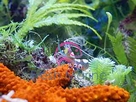Camel Shrimp - Rhynchocinetes uritai - Camelback Shrimp

Taxonomy:Camel Shrimp belongs to the Kingdom Animalia, Phylum Arthropoda, Class Crustacea, Order Decapoda, Family Rhynchocinetidae, Genus Rhynchocinetes and species uritai.
Scientific names: The scientific name of Camel Shrimp is Rhynchocinetes uritai.
Other common names: Camel Shrimp is also commonly known as Camelback Shrimp, Hinge Beak Shrimp, Dancing Shrimp, Candy Shrimp, Humpback Shrimp and Peppermint Shrimp.
Origin or natural range: Rhynchocinetes uritai is found in the Indo-Pacific region.
Size: Camel Shrimp may grow up to a size of two inches.
Color: Rhynchocinetes uritai occurs in red and white colors.
Compatibility: Camel Shrimp is non-aggressive towards the other marine aquarium members.
Habit & Habitat:
- Rhynchocinetes uritai is found in small groups in rock crevices, rocky overhangs, coral rubble and rock caves.
- Camel Shrimp needs to undergo molting as it grows. Molting is a process in which Rhynchocinetes uritai sheds its current and tight exoskeleton to replace it with a new and larger one. Camel Shrimp molts at night when the shrimp lies down on its back and leaves out the old exoskeleton. The new exoskeleton is then secreted by its body which forms and hardens completely in a few hours time.
- Rhynchocinetes uritai hides in rock crevices or rock caves during the molting process to allow the new exoskeleton to form completely and harden.
- Camel Shrimp is hardy.
- The carapace on the body of Rhynchocinetes uritai is striped in red and white colors.
- Camel Shrimp has a moveable beak, called rostrum, which is generally turned upwards.
- The male Rhynchocinetes uritai have larger claws, called as Chelipeds, than their female counterparts.
- Temperature of water: Seventy-two to seventy-eight degrees Fahrenheit.
- Specific gravity of water: 1.023 to 1.025.
- pH of water: 8.10 to 8.40.
- Habit & habitat:
- To host Camel Shrimp, you should have a marine aquarium with a minimum water capacity of ten Gallons.
- You may keep more than one Rhynchocinetes uritai in your marine aquarium having non-stinging corals and stinging anemones.
- Camel Shrimp adjusts to its new marine aquarium environment in a few hours time.
- Feeding & Nutrition: Rhynchocinetes uritai is Carnivorous in feeding habit and eats detritus, phytoplankton, zooplankton and the frozen meaty bits of seafood found on sand.
- Benefits: Camel Shrimp looks for food in the sand by ploughing it and thereby aerating it well.
- Camel Shrimp is easy to maintain owing to its non-poisonous nature.
- Add Iodine as dietary supplement for Rhynchocinetes uritai to smoothen up its molting process.
- High levels of Copper and Nitrates in your marine aquarium may prove detrimental to the health of Camel Shrimp therein.
- Rhynchocinetes uritai is quite vulnerable during molting and should not be disturbed.
- Any fluctuations in the water quality may adversely affect the health of Camel Shrimp.

Cleaner Shrimp - Lysmata amboinensis - Cleaner Red Skunk Shrimp - White-Striped Cleaner Shrimp
Freshmarine: $29.98
You Save 23.11%
Fire Shrimp - Lysmata debelius - Scarlet Cleaner Shrimp - Blood Shrimp - Fire Shrimp
Freshmarine: $43.98
You Save 37.16%
Glass Anemone Shrimp - Periclimenes brevicarpalis - Pacific Clown Anemone Shrimp
Freshmarine: $19.95
You Save 31.18%
Before Placing Your Order
Store InformationShipping Info
Payment Info
Return Policy
Arrive Alive Guarantee
Adoptation Policy
After Placing Your Order
Track Your OrderSecurity Safe Shopping
Compatibility Chart
Shoppers Review










